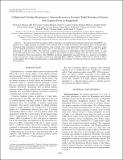| dc.contributor.author | Bhuiyan, Saruar | en_US |
| dc.contributor.author | Sayeed, Abu | en_US |
| dc.contributor.author | Khanam, Farhana | en_US |
| dc.contributor.author | Leung, Daniel T. | en_US |
| dc.contributor.author | Rahman Bhuiyan, Taufiqur | en_US |
| dc.contributor.author | Sheikh, Alaullah | en_US |
| dc.contributor.author | Salma, Umme | en_US |
| dc.contributor.author | LaRocque, Regina C. | en_US |
| dc.contributor.author | Harris, Jason B. | en_US |
| dc.contributor.author | Pacek, Marcin | en_US |
| dc.contributor.author | Calderwood, Stephen B. | en_US |
| dc.contributor.author | LaBaer, Joshua | en_US |
| dc.contributor.author | Ryan, Edward T. | en_US |
| dc.contributor.author | Qadri, Firdausi | en_US |
| dc.contributor.author | Charles, Richelle C. | en_US |
| dc.date.accessioned | 2014-07-07T17:01:43Z | |
| dc.date.issued | 2014 | en_US |
| dc.identifier.citation | Bhuiyan, S., A. Sayeed, F. Khanam, D. T. Leung, T. Rahman Bhuiyan, A. Sheikh, U. Salma, et al. 2014. “Cellular and Cytokine Responses to Salmonella enterica Serotype Typhi Proteins in Patients with Typhoid Fever in Bangladesh.” The American Journal of Tropical Medicine and Hygiene 90 (6): 1024-1030. doi:10.4269/ajtmh.13-0261. http://dx.doi.org/10.4269/ajtmh.13-0261. | en |
| dc.identifier.issn | 0002-9637 | en |
| dc.identifier.uri | http://nrs.harvard.edu/urn-3:HUL.InstRepos:12406547 | |
| dc.description.abstract | We assessed interferon-gamma (IFN-γ) responses via enzyme-linked immunosorbent spot (ELISPOT) to a number of S. Typhi antigens in samples from humans with S. Typhi bacteremia and typhoid fever in Bangladesh. Compared with responses in healthy endemic zone controls, there were significantly increased IFN-γ responses at the time of clinical presentation (acute phase) and at convalescence 14–28 days later. The majority (80–90%) of IFN-γ expressing T cells were CD4+. We observed a significant increase in interleukin-17 (IL-17) positive CD4 + T cells at convalescent versus acute stage of infection using an intracellular cytokine staining assay. We also found that stimulated peripheral blood mononuclear cells (PBMCs) produced significantly increased levels of a number of cytokines at the convalescent versus acute phase of infection, including IFN-γ, MIP-1β, sCD40L, TNF-β, IL-13, and IL-9. These results suggest that S. Typhi antigens induce a predominantly Th1 response, but that elevations in other cytokines may be modulatory. | en |
| dc.language.iso | en_US | en |
| dc.publisher | The American Society of Tropical Medicine and Hygiene | en |
| dc.relation.isversionof | doi:10.4269/ajtmh.13-0261 | en |
| dc.relation.hasversion | http://www.ncbi.nlm.nih.gov/pmc/articles/PMC4047724/pdf/ | en |
| dash.license | LAA | en_US |
| dc.title | Cellular and Cytokine Responses to Salmonella enterica Serotype Typhi Proteins in Patients with Typhoid Fever in Bangladesh | en |
| dc.type | Journal Article | en_US |
| dc.description.version | Version of Record | en |
| dc.relation.journal | The American Journal of Tropical Medicine and Hygiene | en |
| dash.depositing.author | Leung, Daniel T. | en_US |
| dc.date.available | 2014-07-07T17:01:43Z | |
| dc.identifier.doi | 10.4269/ajtmh.13-0261 | * |
| dash.authorsordered | false | |
| dash.contributor.affiliated | Leung, Daniel T. | |
| dash.contributor.affiliated | Calderwood, Stephen | |
| dash.contributor.affiliated | Larocque, Regina | |
| dash.contributor.affiliated | Harris, Jason | |
| dash.contributor.affiliated | Ryan, Edward | |
| dash.contributor.affiliated | Charles, Richelle | |


